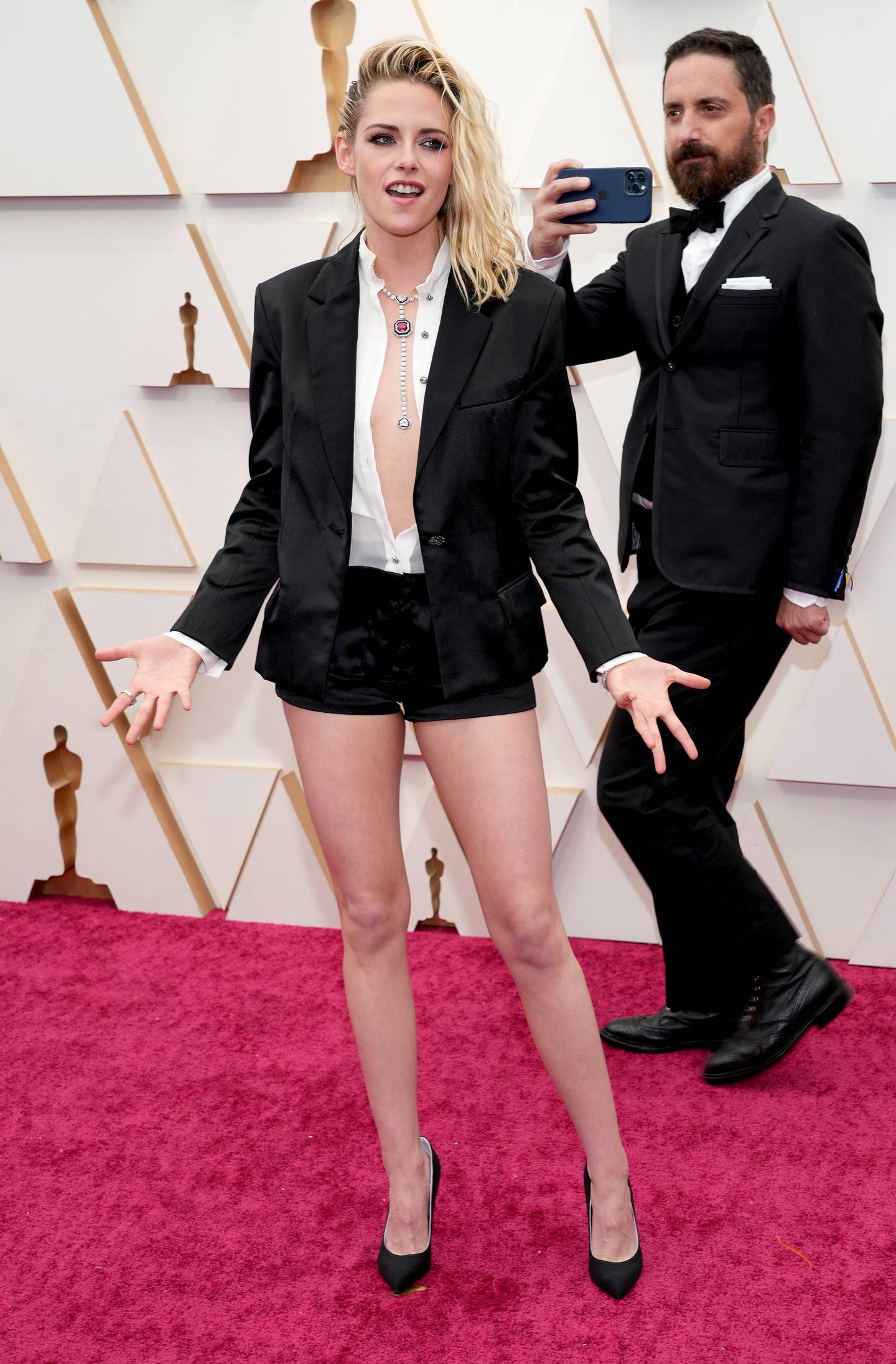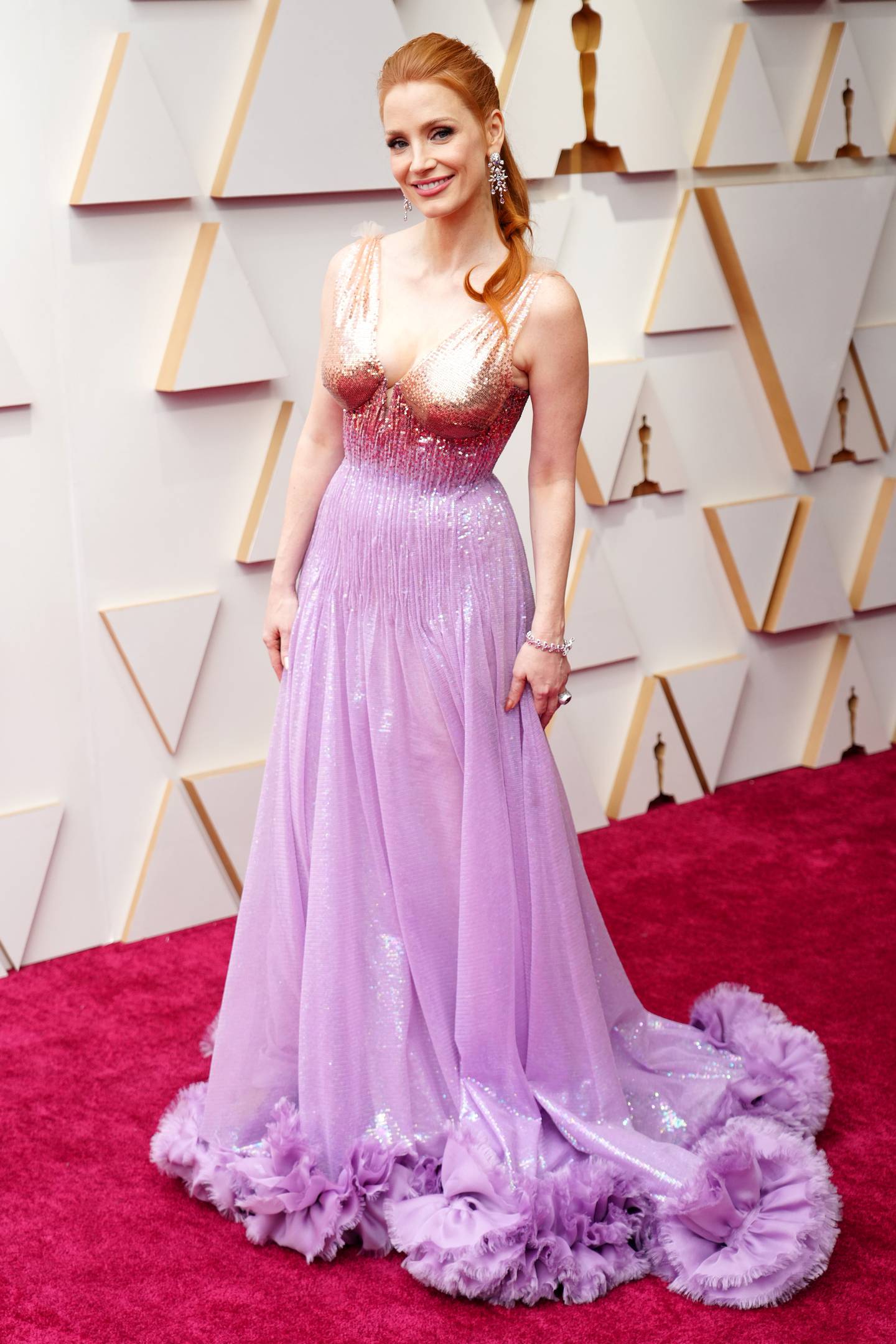
LOS ANGELES — The Oscars, a monumental marketing machine for the American film industry for decades, is in crisis, with no optimal solution in sight. Sunday night’s 94th Academy Awards was a test to see if at least some of the audience lost during the pandemic and beyond can be regained, and a new generation can be persuaded to pay attention. Ratings have taken a 75 percent dive since 2014, according to a report in the Los Angeles Times.
The occasional burst of unscripted drama, à la last night’s Will Smith and Chris Rock tussle, may get people talking again for a minute. But if interest continues to wane, what does it mean for the red carpet? A major advertising opportunity for global luxury brands over the past 25-odd years, its purpose has also changed. All media, not just television, is far more fragmented than it was even two years ago. A gown with some virality typically has a much shorter tail than it did when Nicole Kidman wore that unforgettable chartreuse satin Dior in 1997. Best and worst-dressed lists matter less than they ever did.
What’s more, the pandemic left the styling business in flux. Major studios and streamers, who often pay for actors’ glam-team services when they’re promoting a movie, television show or campaigning during awards season, are offering smaller and smaller fees, leaving stylists to find pay elsewhere. (Most actors don’t want to pay those fees themselves if they can avoid it.) That means an increasing number of stylists are entering exclusive deals with major luxury houses, increasing the dominance of those brands — which often have deals with the stars themselves — on the red carpet.
The question, then, is how long luxury brands will continue to invest so much in a platform that doesn’t have a clear return.
If this week in Los Angeles was any indication, there’s still plenty of confidence in the power of celebrity to advertise. Miu Miu launched the latest installment of its “Women’s Tales,” a series of short films short by female-identifying directors, with “Zola” auteur Janicza Bravo in the chair and dozens of young actors, dressed in Miu Miu, attending the screening. Vanity Fair hosted not one but two parties — a dinner celebrating young Hollywood, sponsored by Lancôme, and then its legendary Oscars-night soirée. Louis Vuitton womenswear designer Nicolas Ghesquière co-hosted W magazine’s annual celebration. And Saturday night, Giorgio Armani threw a party at its newly renovated Rodeo Drive boutique to honour Academy Award-nominee Kidman with hundreds of onlookers crowded behind velvet ropes like it was 2019 all over again. Chanel’s famous pre-Oscars dinner with Charles Finch was back, too.
As for the dresses themselves, best-actress nominees were outfitted entirely by European megalabels. Kidman wore a steel-blue Armani peplum. Penélope Cruz’s navy Chanel halter gown represented the drearier side of designer Virginie Viard’s repertoire, while Stewart’s short shorts — worn with a jacket, sky-high pumps at least a size too big, and an open-front white shirt — stirred the pot, even if it wasn’t entirely shocking. Stewart, more than anyone else who walked the carpet on Sunday, looked like herself. It’s a rare occurrence when a major brand outfits a star in something that clearly pleases her.
Best Actress-winner Jessica Chastain wore ombré Gucci — in the colours of candy hearts — just a day after CEO Marco Bizzarri flew out to Los Angeles to throw a dinner in her honour. That left Olivia Colman as the wildcard, but she also opted for a major name: a silver-pleated, perfectly respectable Dior Haute Couture gown.
The supporting actress contingent stretched a bit further, with “Power of the Dog”-nominee Kirsten Dunst in vintage — lipstick-red, chiffon Christian Lacroix — and “West Side Story”-winner Ariana DeBose also in red — the Valentino kind — while “King Richard” co-star Aunjanue Ellis was wrapped in wisps of burnt-orange Versace chiffon.
The big brands dominated far beyond the nominees. “Licorice Pizza” star Alana Haim and her bandmate-sisters, who also appeared in the film, continued on their Louis Vuitton run, the label that has dominated Haim’s tour of the awards circuit. Occasionally she’s opted for custom Marni, but tonight it was Ghesquière’s tasteful scallops of beads that won. Louis Vuitton, which has significantly raised its red-carpet presence since the designer’s arrival in 2013, also dressed the young star of “Coda,” Emilia Jones, “Belfast’s” Caitríona Balfe and others — to varying degrees of success. But it was the label’s cropped, sequined jacket for “Dune” star Timothée Chalamet, worn without a shirt, that stole the night, only matched by Stewart’s shorts and followed closely by co-star Zendaya’s cropped white shirt and silver skirt by Valentino. (There may not be a better celebrity-and-stylist match than the “Euphoria” star and Law Roach.)

In jewellery, the standout strategy was Cartier’s, which outfitted a broad swath of gentlemen, from Best Actor-winner Smith and Chalamet to Rami Malek and “Power of the Dog”-nominee Kodi Smit-McPhee.
What’s receding is the dominance of traditional red-carpet designers. While Monique Lhuillier and Elie Saab had some quieter moments, more attendees are going the high-fashion route. Jada Pinkett Smith, for instance, wore that ruched, forest green showstopper from Glenn Martens’ Jean Paul Gaultier couture show, while “The Lost Daughter”-director Maggie Gyllenhaal opted for custom velvet Schiaparelli — a squared, off-the-shoulder neckline, with fist-sized, gold-foiled leather “buttons” pinned down the front. Smit-McPhee wore the first major Bottega Veneta-under-Matthieu Blazy red carpet look, a powder blue suit, only to be upstaged by the arrival of Uma Thurman in a perfect, simple white satin shirt and black skirt, also by Blazy. Liya Kebede repped Pieter Mulier’s Alaïa with a keyhole neckline that swooped below her belly button.
There are traditional, gala-friendly brands that have dramatised, or fashionised, their look as the reality of the red carpet has shifted. Caroline Herrera, a favourite of debutantes and Renée Zellweger alike, makes wild enough frocks these days to garner several credits an awards evening. (Most notably, tonight, an expansive, mullet-hem mini for best original song-nominee H.E.R.)
The best looks of the night were sometimes flashy, sometimes loud: qualifiers that were desperately avoided back when stars were also attempting to avoid those dreaded worst-dressed lists. This season, some experts predicted more subdued looks, given that the ceremony was taking place in the foreground of the Ukraine war. Instead, there was a tremendous amount of colour (especially red) and shine — from Chastain’s lavender sequins to Lupita Nyong’o’s floral-spangled Prada — with the occasional blue-and-yellow pin attached to a lapel.
Clearly, there was a real desire on all sides to get back to business. And right now, the red carpet’s prospects are looking up, fashion-wise. How long brands will continue to invest so much time and money in a declining platform, however, is unknown. At the moment, they remain starry-eyed.



